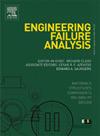A comprehensive numerical study on examining the failure mechanisms of masonry walls via continuous micro modeling
IF 4.4
2区 工程技术
Q1 ENGINEERING, MECHANICAL
引用次数: 0
Abstract
Modeling the failure mechanisms of masonry structures is one of the most challenging issues in structural engineering. This study presents nonlinear analysis to determine the failure mechanisms of masonry walls via continuous micro modeling. The stages of creating a continuous micromodel and applying a nonlinear material model and failure criteria to determine the failure mechanisms of masonry walls are presented. The study systematically and comprehensively examines the failure mechanisms of masonry walls via continuous micro modeling considering different structural scenarios such as dynamic effects and short column effect. Distributions of stresses, strains, occurred under cyclic loads for the masonry walls are determined in dynamic analysis. Nonlinear finite element analyses on masonry walls are performed to investigate the effects of design parameters such as bond style and mortar thickness. Nonlinear structural behavior of confined masonry walls having different infill ratio are analyzed and failure mechanisms of walls are investigated. It was seen that to determine the failure mechanisms of masonry walls, continuous micro modeling technique can be used efficiently in nonlinear structural analysis.
用连续细观模型研究砌体墙体破坏机理的综合数值研究
砌体结构的破坏机制建模是结构工程中最具挑战性的问题之一。本文采用非线性分析方法,通过连续细观模拟确定砌体墙体的破坏机理。介绍了建立连续微观模型、应用非线性材料模型和破坏准则确定砌体墙体破坏机制的阶段。考虑动力效应和短柱效应等不同结构情景,通过连续细观建模,系统、全面地考察了砌体墙体的破坏机理。在动力分析中确定了循环荷载作用下砌体墙体的应力、应变分布。对砌体墙体进行了非线性有限元分析,探讨了粘结方式和砂浆厚度等设计参数对砌体墙体的影响。分析了不同填充比约束砌体墙体的非线性结构特性,探讨了墙体的破坏机理。结果表明,连续细观建模技术可以有效地应用于非线性结构分析中,以确定砌体墙体的破坏机理。
本文章由计算机程序翻译,如有差异,请以英文原文为准。
求助全文
约1分钟内获得全文
求助全文
来源期刊

Engineering Failure Analysis
工程技术-材料科学:表征与测试
CiteScore
7.70
自引率
20.00%
发文量
956
审稿时长
47 days
期刊介绍:
Engineering Failure Analysis publishes research papers describing the analysis of engineering failures and related studies.
Papers relating to the structure, properties and behaviour of engineering materials are encouraged, particularly those which also involve the detailed application of materials parameters to problems in engineering structures, components and design. In addition to the area of materials engineering, the interacting fields of mechanical, manufacturing, aeronautical, civil, chemical, corrosion and design engineering are considered relevant. Activity should be directed at analysing engineering failures and carrying out research to help reduce the incidences of failures and to extend the operating horizons of engineering materials.
Emphasis is placed on the mechanical properties of materials and their behaviour when influenced by structure, process and environment. Metallic, polymeric, ceramic and natural materials are all included and the application of these materials to real engineering situations should be emphasised. The use of a case-study based approach is also encouraged.
Engineering Failure Analysis provides essential reference material and critical feedback into the design process thereby contributing to the prevention of engineering failures in the future. All submissions will be subject to peer review from leading experts in the field.
 求助内容:
求助内容: 应助结果提醒方式:
应助结果提醒方式:


